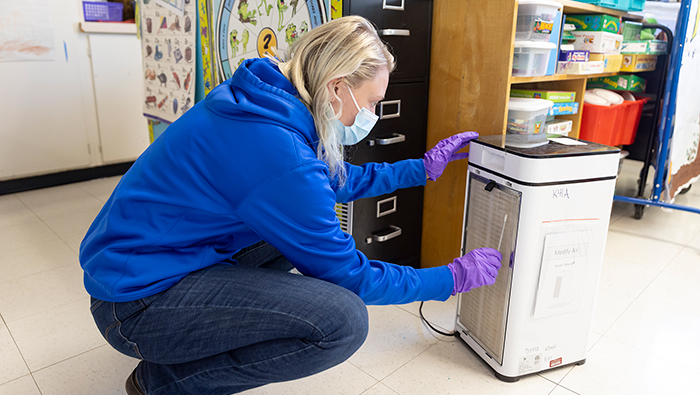
How do you test an elementary school classroom for COVID-19 every day? How about a residence hall building? An entire neighborhood? A pair of UC Davis researchers working with Healthy Davis Together, the city-university partnership to keep the community safe from the pandemic, has the answers: monitoring wastewater and air filters.
Heather Bischel, an assistant professor of civil and environmental engineering, and David Coil, a project scientist with the Genome Center, co-lead an initiative with Healthy Davis Together to collect regular samples from wastewater on campus and around the city of Davis, along with a pilot program earlier this year to swab stand-alone HEPA air filters inside two elementary schools in Davis.
They said while COVID-19 testing has come a long way since the start of the pandemic, testing large groups of people on a regular basis is still impractical and too expensive. These techniques allow them to look for trends in COVID-19 infection in large areas all at once.
“We can detect the RNA of the virus and measure the concentration,” Bischel said. “It’s intended to help target communications if there’s an uptick in one or more areas of the city.”
Wastewater testing expanding
Bischel said wastewater testing, which looks for virus RNA shed in feces, is happening in Davis at citywide and neighborhood-specific levels. On campus, the wastewater from individual residence halls is monitored to discover if the residents of those buildings could benefit from more outreach.
Environmental testing is meant as a backup to individuals getting testing for the virus, and that data could prove even more valuable as testing rates go down and vaccination rates increase, she said.
“Wastewater is a passive system,” Bischel said. “It’s a lower burden to keep an eye out if there are resurgences of the virus.”
In July, when wastewater from some areas of Davis showed elevated levels of virus particles and clinical tests showed a jump in residents contracting the delta variant, Healthy Davis Together staff issued a news release and distributed door hangers encouraging testing for people who have been at risk for exposure. In March, the organization sent text and email alerts to people in a neighborhood where wastewater showed an increase.
She said while monitoring is unlikely to be used in non-residential buildings on campus to provide targeted notifications because too many different people pass through them, such monitoring could give a pulse on the general presence of COVID-19 on campus. The Healthy Davis Together team is also working to test samples from wastewater treatment plants that might not have the staff or equipment to do the monitoring themselves, both elsewhere in Yolo County and in Merced and Stanislaus counties.
Air filter monitoring readily available
After living with the pandemic for more than a year, most people are likely familiar with COVID-19 tests taken from nasal swabs. Now imagine doing that same test, but by swabbing the air filter from an HVAC unit in an elementary school classroom — that filter could contain viral particles from the breath of students and teachers, as well as errant particles attached to their clothes.
“The science of the test is technically similar, but the information you get is very different,” Coil said. He oversaw an eight-week pilot program this spring at two schools in Davis to do just that, and said the data it provided was specific enough to do some targeted outreach.
“One [school] was basically never positive, while the other had multiple classrooms — sometimes repeated classrooms” that tested positive, he said. “We knew we couldn’t track it down to, ‘This person was positive,’ but we could direct testing resources, vaccination information and other communications to the place where there’s a problem.”
Because stand-alone air filters and testing supplies are nearly ubiquitous, air filter monitoring could be done virtually anywhere and with viruses other than COVID-19 — but it only makes sense in certain situations, Coil said.
“We had a couple businesses approach us about doing air filter monitoring, and we said it didn’t make sense,” he said, noting they were based in small offices where employees could easily get tested individually. “What information would you gain?”
On the other hand, places like in-home daycares or special education schools with vulnerable populations who may not be able to get tested could benefit greatly from the monitoring, Coil said. His team was in talks with the Yolo County Office of Education at the time this article went to press, and was working to publish their findings to increase awareness.
“It took us a long time to get mass testing up and deployed at a wide scale,” he said. “This is something you could deploy immediately.”